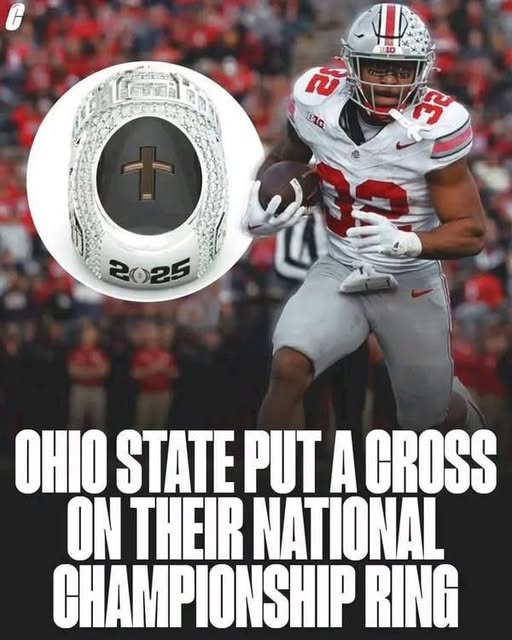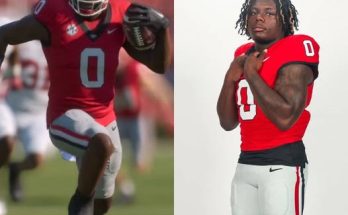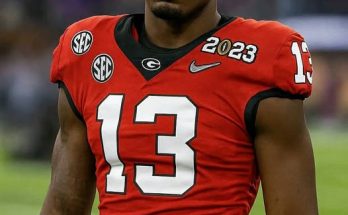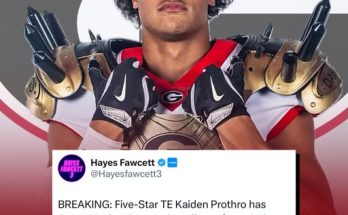Ohio State Championship Rings’ Religious Symbolism Brings Faith and Fury Together
In the world of college football, few programs generate as much conversation—both praise and criticism—as the Ohio State Buckeyes. Their legacy, talent pipeline, and championship aspirations are routinely in the national spotlight. But in a surprising twist that’s taken both the sporting and social world by storm, the unveiling of Ohio State’s latest championship rings has ignited a different kind of dialogue—one not centered on football itself, but on the powerful, polarizing intersection of faith and athletic achievement.
The Buckeyes’ commemorative rings, which celebrate their 2024 Big Ten Championship and College Football Playoff berth, are undeniably stunning. Encrusted with diamonds, the iconic Block “O,” and symbols representing their triumphs, the design is bold and unmistakably elite. However, it wasn’t the sparkle or size of the ring that sparked headlines—it was the inclusion of prominent Christian symbolism.
Etched into the inner band of each ring is the phrase “Audience of One” alongside a gleaming cross. For some, this subtle but deliberate inclusion is a nod to the deep faith that guides many athletes. For others, it has ignited a firestorm over the blurred lines between personal beliefs, public institutions, and inclusivity in team settings.
As the dust settles on what’s become an unexpectedly charged moment in college athletics, questions emerge: Where should the line be drawn between faith and football? Does honoring personal convictions come at the cost of alienating others? And most importantly, who gets to decide what symbols belong in a championship legacy?
A Statement of Faith
When Ohio State Head Coach Ryan Day unveiled the championship rings during a private team ceremony at the Woody Hayes Athletic Center, emotions ran high. Day, who has spoken openly in past seasons about his own Christian faith and the spiritual values he encourages in his program, reportedly addressed the team with the words: “This is more than football. This is about purpose.”
The ring, designed in collaboration with Jostens, features an intricate outer band celebrating key moments from the season: wins over Penn State and Michigan, the Big Ten title date, and the team’s playoff berth. But inside, Day and several senior leaders pushed for a message they believed captured the heart of the team’s bond.
“Audience of One is what we say before every game,” senior linebacker Mitchell Johnson shared in an emotional social media post. “It means we play for God first. He gives us strength, direction, and unity. This season, we wanted that reflected in how we celebrate.”
The cross etched beside the phrase is modest in size but unmistakable. Players were not required to endorse the message, but no alternate ring design was offered—each player received the same version.
While many players embraced the gesture, some quietly questioned the move. An anonymous player reportedly told The Lantern, Ohio State’s student newspaper, “I respect everyone’s faith, but I wish we had been asked more directly. Not everyone on this team believes the same way, and that’s okay too.”
The Reaction: Applause and Backlash
Unsurprisingly, the story exploded beyond campus lines the moment images of the ring circulated on social media. Supporters, especially within the Christian community, hailed the Buckeyes for standing firm in their faith in an era that often pressures public figures to remain neutral.
“Ohio State just reminded us that courage isn’t only on the field,” tweeted one Ohio pastor. “They’re leading with conviction, and our young men need more of that.”
Conservative outlets praised the program for “boldly acknowledging the foundation of faith,” while prominent Christian athletes across the NFL and NCAA voiced their support. Former Buckeye and current NFL running back J.K. Dobbins called it “a beautiful tribute to the One who makes all things possible.”
But the rings also drew sharp criticism.
Civil liberties organizations like the Freedom From Religion Foundation and Americans United for Separation of Church and State issued statements calling the design “constitutionally problematic” and “exclusionary.” They argued that a public university like Ohio State must remain neutral on religious matters, especially in team-issued memorabilia funded—at least in part—by public money.
“This isn’t about silencing faith,” the FFRF statement read. “It’s about recognizing that public institutions must serve everyone equally, regardless of belief. The ring implies a religious orthodoxy that may make non-Christian players feel marginalized.”
A handful of Ohio State alumni also voiced concern. “As a Jewish graduate and lifelong Buckeye fan, I felt a little uneasy seeing the cross on the ring,” wrote one former OSU student in a widely shared Facebook post. “We celebrate team, not theology.”
NCAA and Legal Gray Areas
Legally, the controversy treads in murky waters.
The First Amendment guarantees both freedom of religion and freedom from religious coercion, especially in public institutions. However, courts have historically upheld the right of individuals, including athletes, to express personal faith—so long as it isn’t mandated or institutionally enforced.
What complicates matters is the nature of the ring itself. Because the ring was team-issued and designed in collaboration with the coaching staff, critics argue that it crosses the line from personal to institutional expression.
“There’s a difference between a player writing a Bible verse on their cleats and a public university engraving a Christian slogan onto a championship ring,” legal scholar Dr. Kendra Hill told ESPN. “It sends a message, whether intended or not, about who belongs—and who doesn’t.”
As of now, no legal action has been taken, but advocacy groups say they’re monitoring the situation closely.
The Players Speak Out
In the wake of the controversy, several Buckeye players have taken to social media to share their personal views—both in support and with respectful dissent.
Star quarterback Dante Westfield posted on Instagram: “This season tested us in every way. For me, my faith kept me centered. I respect every teammate and every belief, but the ring means something personal to me.”
Conversely, defensive back Jalen Nguyen, a practicing Buddhist, shared a thoughtful perspective: “I’ve always felt respected by my brothers on this team. I would’ve liked a design that was a bit more inclusive, but I know the intent came from a place of love.”
Coach Day later addressed the media, acknowledging the discourse but standing by the design. “We never set out to offend anyone,” he said. “We wanted to reflect what this team said in the locker room all year long. Faith, for many of these young men, is their compass.”
He also emphasized that no one was required to wear the ring publicly, and players could choose to keep it private.
Larger Conversations on Faith and Sports
This isn’t the first time faith-based symbolism in sports has made national headlines. Tim Tebow’s eye black verses, Dabo Swinney’s devotionals at Clemson, and pregame prayers at public high schools have all sparked debate over where personal conviction ends and institutional endorsement begins.
But this Ohio State case has struck a deeper chord, perhaps because it touches on identity, inclusion, and the very purpose of sport itself.
“College football is a melting pot,” said former ESPN analyst Jemele Hill. “You’ve got kids from every walk of life, every creed. Celebrating one faith on a championship ring—especially without consensus—sends a message. Whether that message was intended or not is irrelevant to the people who feel sidelined by it.”
On the flip side, faith continues to be a foundational pillar for many athletes.
“There’s a misconception that faith expression is always exclusionary,” noted Rev. Tony Dungy, former NFL coach. “But for many young men, their faith is what helps them play the right way, live the right way, and treat others with respect.”
Where Does Ohio State Go From Here?
For now, the university has not indicated it will revise or recall the rings. The athletic department released a brief statement affirming their commitment to inclusion, saying, “We respect the diverse backgrounds of our student-athletes and remain committed to providing a welcoming environment for all.”
But internal conversations are reportedly ongoing. Some boosters have called for greater transparency in future ring designs, while others have encouraged Ohio State to “stand firm” in the face of criticism.
As the Buckeyes look toward the 2025 season, ranked once again among the top contenders for a national championship, this moment may ultimately be remembered as more than a PR flare-up. It’s a cultural flashpoint—one that forces players, coaches, fans, and administrators to wrestle with difficult but necessary questions.
What does it mean to be a team in a world that’s more diverse than ever? How do institutions balance the celebration of individual values with the mandate to remain inclusive? And can faith and football coexist in a way that uplifts everyone?
Final Word: Faith, Fury, and the Future
The Ohio State championship ring controversy has undeniably brought faith and fury together in a way that few anticipated. But perhaps that’s the most compelling legacy of this moment—it shows that college football, long a microcosm of American identity, still has the power to spark dialogue that extends far beyond the field.
For some, the ring is a symbol of divine gratitude. For others, a troubling emblem of exclusion. But for all, it’s a reminder that even in celebration, the choices we make carry weight far beyond diamonds and gold.
As the Buckeyes move forward, they do so not just as champions of a sport—but as central figures in a national conversation about belief, belonging, and the bridges we build—or burn—through the symbols we choose to honor.



